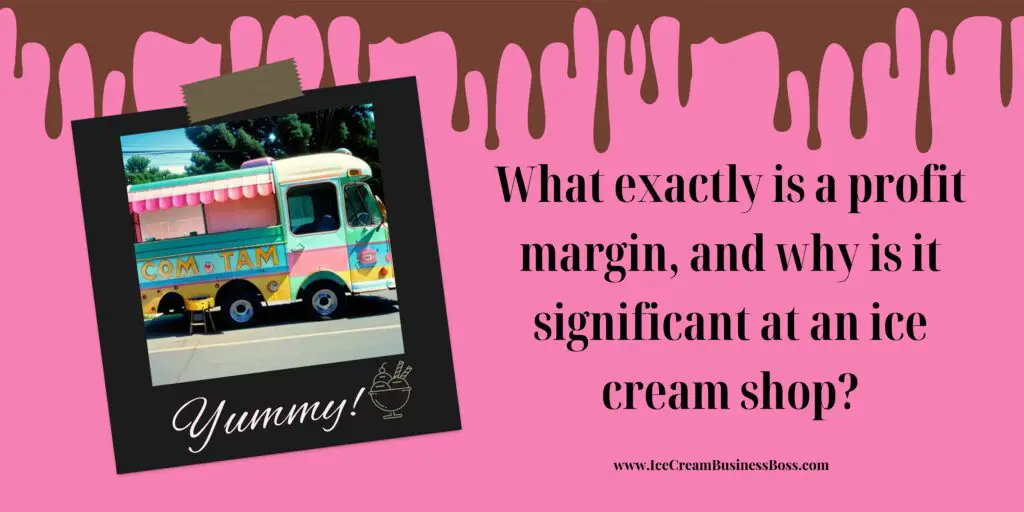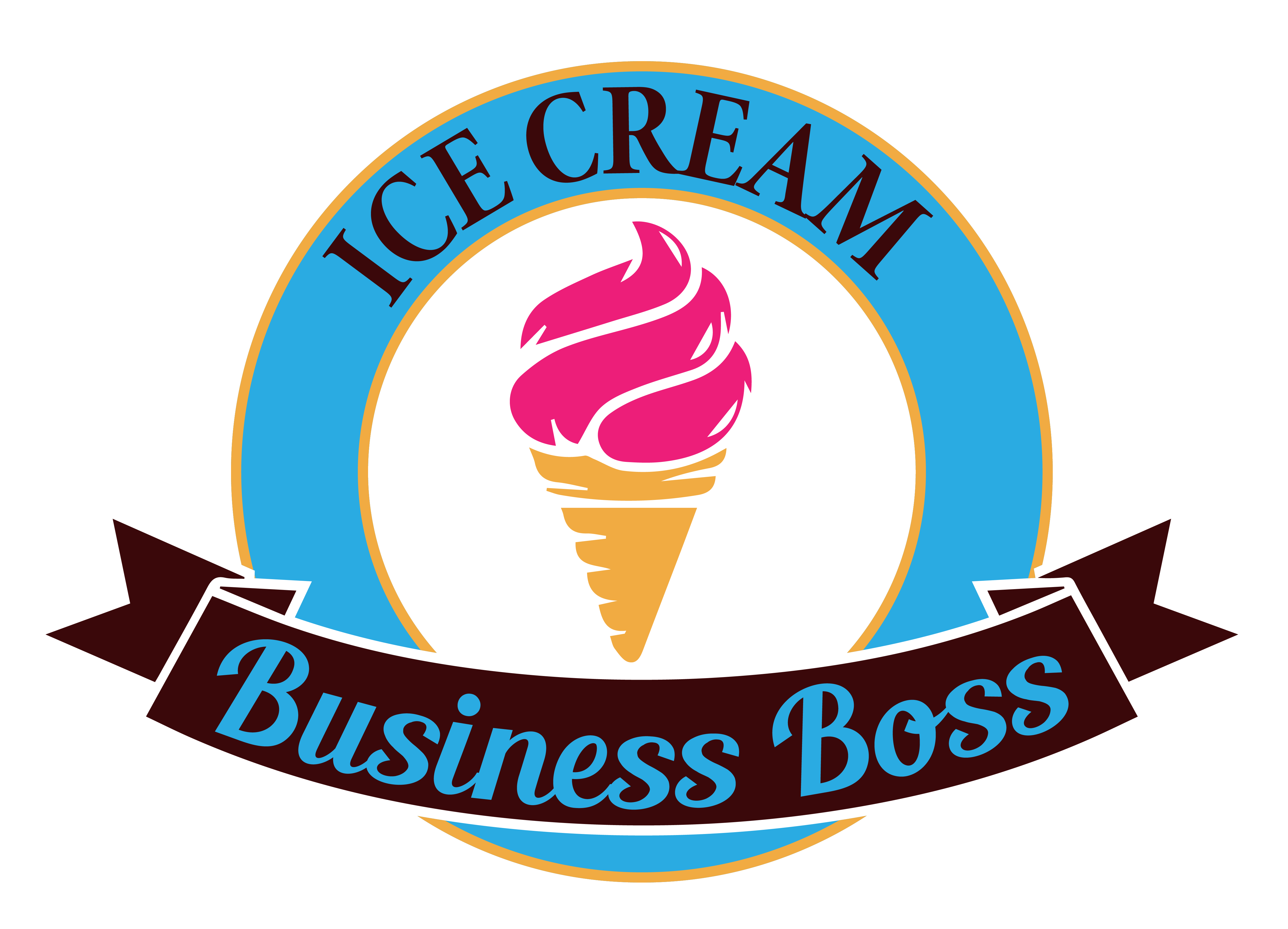Owning an ice cream store can be a dream come true for many entrepreneurs who enjoy frozen treats and delicious confections. Yet, among the whirlwind of invention and joyous client encounters, there is one critical factor that can make or break the venture’s fulfillment: the profit margin. Understanding the dynamics of profit margins in the ice cream business is not only insightful but also necessary at the heart of financial sustainability.
To ensure a solid start, you should begin by understanding that an ice cream shop’s profit margin typically varies from 15% to 30%, influenced by factors such as location, pricing strategy, and operational efficiency.
This article digs into the fascinating world of ice cream store profit margins, investigating the factors that drive this important metric, the average range it falls within, and how businesses can navigate the path to profitability while satisfying taste buds along the way.
The Significance of Profit Margin
Profit margin is a crucial and illuminating indicator that provides a deep understanding of a company’s financial health. It is an effective technique for assessing how well cost- and revenue-management strategies work. Profit margin specifically denotes the percentage of total revenue that results in profit after deducting all related costs and expenses.
This statistic assumes an even greater significance in the microcosm of an ice cream shop. Profit margin serves as a bright beacon in this situation, exposing the store’s innate ability to both create sales and turn those sales into substantial profits. Knowing the profit margin is crucial for the establishment’s survival and growth because the frozen confectionery industry depends on consumer preferences and seasonal variations.
Any ice cream shop’s financial soundness cannot be determined solely by its revenue. The profit margin displays the portion of income that is left as a tangible profit by taking into account the expenditures incurred during production, operation, marketing, and other related activities. A strong profit margin suggests cost minimization and effective resource management, both of which are essential to a company’s growth.
The ice cream industry requires a careful analysis of profit margins due to the delicate balance between raw material costs, labor costs, and operational overhead. If profit margins are low, it may be time to make strategic changes, such as streamlining the manufacturing process, renegotiating supplier agreements, or adding higher-margin items to the menu.
On the other hand, strong profit margins show that the company is managing its financial resources as well as luring customers.
Any business, including an ice cream shop, should strive for both sustainability and growth. Without a stable profit margin, a company may find it difficult to pay its bills and make investments in growth prospects. Gainful operations allow the shop to contemplate investing in diversification, regional development, or technical advancements in addition to maintaining its current services.
Check out our article to learn more about ice cream shop’s profitability.
Understanding the Range

Ice cream shops stand out as lovely havens among the dynamic landscape of the culinary world, encapsulating the essence of sweetness and joy. However, the survival and prosperity of these enterprises are ultimately determined by a complicated interaction of financial considerations. Profit margins, which frequently range between 15% and 30%, provide a revealing insight into the ice cream businesses’ dynamic economic environment by demonstrating the complex interplay between revenues and expenses.
The range of profit margins that fall within this range reflects how diversified the industry is. This diversity is influenced by variables like location, operational scale, product variety, and pricing tactics. Urban ice cream shops with busy city center locations may have greater overhead expenditures for personnel, utilities, and rent, which will affect their profit margins. Smaller stores tucked away in suburban neighborhoods, on the other hand, can benefit from cheaper costs, resulting in a more favorable margin.
Profit margins are also impacted by ingredient quality and procurement methods. Premium ingredients may improve the ice cream’s flavor and attractiveness, but they also are more expensive. On the other hand, choosing inexpensive ingredients can lead to a reduced overall product cost, potentially increasing the profit margin. Maintaining customer pleasure while preserving financial viability requires striking the correct balance between quality and cost.
Seasonal variations are also a major factor in ice cream store profitability. During the warmer months, sales frequently increase, increasing revenue. However, there are drawbacks to this seasonal demand, including higher ingredient costs and more intense competition. Utilizing peak times and reducing off-peak slumps require effective inventory management and pricing modifications.
Profit margins are also affected by innovation and differentiation tactics. An ice cream store might stand out by offering distinctive flavors, specialty concoctions, or catering services. This will allow it to charge higher rates and possibly increase its profit margin. Engaging marketing initiatives, a strong social media presence, and partnerships with neighborhood events can all increase traffic and profitability.
An ice cream shop’s operational effectiveness is crucial in establishing its profit margin. The bottom line can be improved by streamlining production procedures, cutting waste, and optimizing personnel scheduling. It’s crucial to regularly evaluate operational procedures to spot potential improvement areas and preserve a healthy profit margin.
Location, Location, Location
Unquestionably, an ice cream shop’s location affects its profit margin significantly and serves as a silent growth orchestrator. It is impossible to exaggerate how important location is in determining the financial future of these businesses. A prime location with lots of foot traffic appears as a beacon of possibility, able to lift profit margins to new heights and drive sales to dizzying heights.
A shop benefits from exposure and accessibility when it is close to busy thoroughfares, vibrant shopping areas, and enticing tourist hotspots. The tantalizing promise of frozen treats draws a continuous stream of consumers to this opportune location. Both the top and bottom lines are significantly boosted by the lively ambiance and frequent influx of potential customers that foster an environment favorable to impulse purchases. These busy areas are when the profit margin optimization symphony finds its climax.
Contrastingly, the story changes when an ice cream business establishes itself in a less traveled area. The attempt to draw clients becomes an uphill battle as the allure of dense foot activity fades into the distance. It becomes harder to draw visitors as there are fewer onlookers to arouse interest. The resulting trickle of clients might cause sales to stagnate and, inevitably, profit margins to shrink.
Beyond foot traffic, the demographic makeup of the neighborhood has its gravitational pull on the trajectory of the profit margin. It’s like having the key to a treasure chest when you comprehend the distinctive interests, dispositions, and purchasing behaviors of the local populace.
With the help of these perceptions, the ice cream parlor may create a menu that is specific to the preferences of the neighborhood, guaranteeing that every scoop is a satisfying bite. When marketing initiatives resonate with the very essence of the local customer, they too turn become works of art.
The profit margin acquires a new ally in the quest for wealth as the ice cream store shapes its goods to reflect the cravings of its community. Location and demographic preferences have a strong relationship, and this relationship fosters a beautiful synergy that propels both sales and the elusive art of client loyalty.
Crafting the Perfect Pricing Strategy

The threads of an ice cream shop’s pricing strategy are woven with both art and science in the complicated tapestry of factors affecting its profit margin. The delicate balance between affordability and profitability is at the center of this strategic dance, creating the future of the shop’s financial environment like a maestro orchestrating a symphony.
A well-calculated price plan can either draw in large numbers of customers or drive them away, becoming an architect of both sales volume and profit margins. A wide range of potential customers are drawn to the appeal of delicacies at affordable prices.
By casting a wider net, the ice cream store can anticipate more customers and sales, which will improve the overall image of its financial situation. This tactic not only promotes a welcoming atmosphere but also cultivates the steadfast patronage of families, students, and money-conscious people.
There is a thin line between competitive pricing and harmful underpricing, though. While a race to the bottom may be quick, it is rarely long-lasting. Prices that are set too low might undermine the fundamental basis of profitability, shackling the ice cream business under the weight of ongoing expenses and ingredient costs. The reality of operating at a deficit dwarfs the attraction of increasing sales volume.
The appeal of premium pricing, in contrast, exudes a distinct atmosphere of luxury and exclusivity. A strong motivator for purchasing is the idea that more expensive things must be of higher quality and better taste. This strategy gives the ice cream shop the chance to enjoy increased profit margins per sale, which acts as a buffer against any changes in sales volume. It is a tactic with its limitations, though.
Choosing premium pricing may restrict the store’s customer base to people with disposable income. Such customers’ discriminating tastes forbid the provision of inferior goods or experiences, necessitating a higher standard of quality. While potentially thriving, this route calls for a careful balancing act between ensuring quality and upholding a sense of value.
Contextual understanding is crucial in developing a pricing strategy that aligns with the intended profit margin. The strands in this elaborate tapestry that direct the needle are local economic circumstances, competition pricing, and perceived value. The pricing symphony can be produced by skillfully combining market study and a thorough understanding of the target market, leading to results that are pleasing to the ice cream business and its customers.
Explore the world of ice cream shop’s profit margin by checking out this article here.
Efficiency: The Operational Advantage
The bedrock of operational efficiency, which ice cream shops also embrace to blaze the way to prosperity, is at the core of every firm. In the icy world of frozen treats, this complex interaction between gainful operations and profit margins is what makes a well-oiled establishment.
Operational efficiency serves as the link connecting cost structures to profit margins and is not just a trendy term. The capacity of an ice cream store to carefully manage its inventory is comparable to conducting a symphony, with each ingredient harmonizing to produce mouthwatering compositions. Effective inventory management ensures that resources are wisely used, eliminating waste and unnecessary costs, by tracking ingredient use and replenishment needs.
Waste is a concept that goes beyond only financial matters. Waste reduction assumes a complex relevance as the world focuses on sustainable practices. By purposefully lowering waste, the ice cream parlor supports environmental protection while also protecting priceless materials that may otherwise reduce profit margins. The importance of waste reduction in the operating equation is shown by this twofold impact.
Optimized worker schedules are a vital part of operational efficiency. It’s critical to schedule the appropriate quantity of staff at the appropriate times, much like a choreographer arranging a ballet. The store needs to be set up to handle an increase in client demand during peak hours. In contrast, off-peak hours demand a smaller workforce to avoid irrational labor expenditures. The ice cream shop achieves this balance by maximizing productivity without sacrificing financial responsibility.
The key to effective operations appears to be streamlining the production procedures. The gratifying results of enhanced manufacturing are quicker service and lower customer wait times. An ice cream shop may produce on time and flavor with creative process reengineering. Customers respond favorably to this increased efficiency, which improves their experience and might lead to repeat business.
The incorporation of digital solutions accelerates the path to operational excellence. The ice cream store can use inventory management software and point-of-sale systems as digital friends to help them make data-driven decisions.
These technologies offer a comprehensive perspective of operations by monitoring sales, controlling inventories, and assessing client preferences. Strategic decisions aimed at maximizing operations and raising profitability are made easier from this vantage point.
Frequently Asked Questions
What exactly is a profit margin, and why is it significant at an ice cream shop?

Profit margin is the percentage of income that remains as profit after all costs and expenses are deducted. It denotes the ability of an ice cream shop to produce money from its sales. Understanding and improving profit margins is critical for the shop’s long-term viability, growth, and financial health.
What variables lead to ice cream businesses’ profit margins ranging from 15% to 30%?
Several things influence the ice cream shop’s profit margin range of 15% to 30%. Location is important; good locations with considerable foot traffic can lead to increased sales and profitability.
Pricing strategy is also important; striking the correct combination between affordability and profitability is critical. Operational efficiency, such as inventory management and streamlined operations, has an impact on cost structure and, as a result, profit margins.
How can I secure a start for my ice cream shop while keeping profit margins between 15% and 30%?
To get a good start, conduct extensive research on potential locations with strong foot traffic and suitable client demography. Create a pricing plan that takes into account expenses and market trends.
Concentrate on operational efficiency through streamlining procedures and leveraging technology. Maintain a healthy profit margin within the industry’s average range by regularly monitoring and adjusting strategies based on customer feedback and market changes.
The information provided by IceCreamBusinessBoss.com (“The Site”) is for general informational purposes only. All information on the Site is provided in good faith, however, we make no representation or warranty of any kind, express or implied, regarding the accuracy, adequacy, validity, reliability, availability, or completeness of any information on the Site. Under no circumstance shall we have any liability to you for any loss or damage of any kind incurred as a result of the use of the Site or Reliance on any information provided on the Site. Your use of the Site and your reliance on any information on the Site is solely at your own risk. This blog post is for educational purposes only and does not constitute legal advice. Please consult a legal expert to address your specific needs. Terms and Conditions.

Hi! I am Shawn and I am a happy individual who happens to be an entrepreneur. I have owned several types of businesses in my life from a coffee shop to an import and export business to an online review business plus a few more and now I create online ice cream/gelato business resources for those interested in starting new ventures. It’s demanding work but I love it. I do it for those passionate about their business and their goals. That’s why when I meet a ice cream/gelato business owner, I see myself. I know how hard the struggle is to retain clients, find good employees and keep the business growing all while trying to stay competitive.
That’s why I created Ice Cream Business Boss: I want to help ice cream and gelato business owners like you build a thriving business that brings you endless joy and supports your ideal lifestyle.

